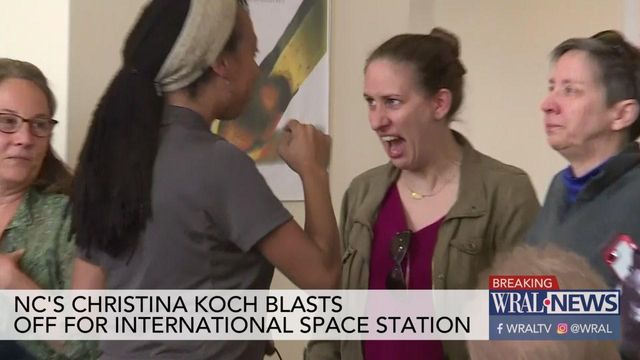NC astronaut blasts off for International Space Station visit
North Carolina’s astronaut, Christina Koch, made her first trip to space on Thursday, at 3:14 p.m. EDT with a launch from the Baikonur Cosmodrome in Kazakhstan.
Koch grew up in Jacksonville, graduating from the North Carolina School of Science and Mathematics in Durham in 1997. She went on to North Carolina State University to earn a Bachelor of Science degree in Electrical Engineering in 2001, an additional bachelors degree in Physics and a masters degree in Electrical Engineering the following year.
At a watch party Thursday afternoon on the N.C. State Campus, the crowd held their collective breath as Koch rocketed into space before breaking out in thunderous applause.
Koch will spend six months on the International Space Station and, next week, will take part in the first all-women spacewalk. For N.C. State and the people who know Koch, the mission will likely inspire generations to come.
"What a wonderful role model that I've had the privilege of meeting twice and little girls all over America are going to see, and actually all over the world," N.C. State's Interim Associate Dean of Academic Affairs Jamila Simpson said.
When Koch got the call from NASA that she’d been accepted as a part of the 2013 astronaut candidates class, she was at NOAA’s American Samoa Observatory where she served as station chief, monitoring atmospheric gases, particles and radiation to better understand climate forcing, ozone depletion and air quality. She’s previously done similar work at NOAA’s monitoring facilities in Barrow, Alaska.
Koch’s NASA career began at NASA Goddard Space Flight Center’s Laboratory in Maryland where she worked on several scientific instruments flying aboard missions exploring the solar system. She went on to Johns Hopkins University’s Applied Physics Laboratory where she continued designing instruments. Her contributions included the Energetic Particle Detector Instrument aboard the Juno spacecraft currently studying Jupiter and the X‐ray Spectrometer Instrument aboard the Suzaku Mission studying the Van Allen radiation belts.
She's won multiple awards for her work including group awards and the United States Congress Antarctic Service Medal.
N.C. State Professor Stephen Reynolds was Koch's advisor. He said he's not surprised she achieved her dream of becoming an astronaut.
"She had this crazy dream of being an astronaut," Reynolds said. "In fact, she was a graduate student in engineering while she was still an undergraduate in physics, which caused some heads to explode in the administration, but she just picked her path and stuck to it."
Koch isn’t one to stay in the lab all the time though.
She built on her love of the outdoors and challenged herself, physically and technically, first with a rock climbing class at NCSU. She took that to the extreme as a part of the United States Antarctic Program where she not only worked at the Admunsen‐Scott South Pole Station but was also part of the firefighting team there including time over the extreme harsh winters. She then spent multiple winters doing science at Summit Station in Greenland.
Since selection for the astronaut program in June 2013, she has undergone extensive training in in International Space Station systems, spacewalks, robotics, physiological training and water and wilderness survival training. She also learned to fly the T-38 aircraft.
These high performance jets aren’t just company cars, providing transportation for astronauts to from their Houston homes near the Johnson Spaceflight Center. They also provide valuable experience for astronauts in the kind of G-forces they’ll be experiencing during launch. But more importantly, they train you to think fast.
Koch has also been spending time at NASA's Neutral Bouyancy Laboratory. This 40-foot-deep pool has full sized mockups of the International Space Station modules Koch will be navigating with fellow NASA astronaut Anne McClain. Next week's spacewalk will focus on upgrading batteries that keep the station running as it passes through to the dark side of the Earth every 45 minutes.
As Koch's determination took her all the way to NASA, she never forgot her alma mater.
"The fact that she could do something with her degree that wasn't just something expected, it was something out of the ordinary, shows that women in physics could do anything," N.C. state physics graduate Emily Brown said.











